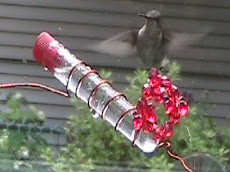Hummer News – Vol. 7 – March 2010
Time to prepare all your feeders and nectar tubes
If you haven’t already done so, now would be a very good time to clean all bird feeders, not only your hummer feeders with a mild, 10% bleach solution and a good rinse before the season begins. For you year round folks, spring would always be a good time to do a thorough clean-up, as well as several other times each year. Anytime that any black residue is building up on any nectar feeder or part, it is essential for the health of your visitors to give everything a good scrubbing.
MerrComm Product Feedback Welcomed and Strongly Encouraged
I am especially interested to hear any feedback from recent customers who have purchased a Roseburg™ 4-tube feeder, a Hummer Stik™ hand held feeder, a Nectar Tube cleaning brush set or Nectar storage and dispensing bottle. I want all of these products to be the best I can make them and your feedback is a very important component to in helping me accomplish that.
Our blog awaits and welcomes you…
Please visit your blog Hummingbird Haven and better yet, please jump in. I have just posted a new video from southern California and will be putting up the fact and instruction sheets for all the current products. If you’ve lost the email inviting you to be a fully enabled post author, just drop me an email and I will send a new one. Just reply to that invitation and join the fun. Find the blog here: http://hummerhaven.blogspot.com/
Happy Hummers and Sweet Dreams of Spring, just around the corner until the next time…
Copyright 2010, Merritt Communications, Inc. – All Rights Reserved





